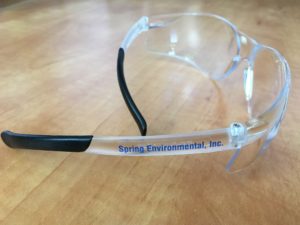The June HAZWOPER Challenge is now closed. Thank you for participating. Please come back July 1st for our next HAZWOPER Challenge!
BREAKING NEWS…2024 EMERGENCY RESPONSE GUIDEBOOKS HAVE ARRIVED!

Be the first in your office to have the new 2024 Emergency Response Guidebook (ERG) by registering for one of our upcoming HAZWOPER or Hazardous Material Transportation courses. Visit our registration platform to see our schedule and register for an upcoming class.
May HAZWOPER Challenge
It’s Warming Up, Time to Review the Outdoor Heat Exposure Rules!
Washington State Department of Labor & Industries’ (L&I) permanent rules for Worker Outdoor Heat Exposures went into effect July 17, 2023. With predicted warmer and drier seasons ahead, make sure you are protecting your employees in accordance with the standards.
The year-round standards apply when the action levels outlined in Table 1 – 52 degrees Fahrenheit for Non-Breathable clothing and 80 degrees Fahrenheit for all other clothing – are exceeded. Employers and employees should educate themselves on the triggering events and what actions must be taken to ensure worker safety. Some key aspects to consider include:
• Definitions
• Response to heat induced illnesses
• Information and Training program requirements
• Shade requirements
• Acclimatization guidelines
For more information, check out the Be Heat Smart (wa.gov) for access to the standards and resources such as posters, videos, and training materials.
* The Federal rulemaking for Heat Illness Prevention in Indoor and Outdoor work settings is currently in the Pre-rule stage of development.
April HAZWOPER Challenge
March HAZWOPER Challenge
2024 NEW OSHA 300A Posting and Reporting Requirements
Hello 2024! Did you know there are new requirements for companies to electronically submit workplace injury and illness data to OSHA? There is and it’s also time to prepare, certify and post your OSHA 300A Annual Summary of workplace injuries and illnesses in your workplace. Under the new rule, the following establishments have to submit electronically:
• Designated industries that had a peak employment of 100 or more employees during the previous calendar year that are listed in Appendix B to Subpart E of 29 CFR Part 1904.
• Establishments with 20 to 249 employees in certain industries listed in Appendix A to subpart E of 29 CFR Part 1904.
• Establishments with 250+ employees in industries that must routinely keep records.
If employers in State Plan states (e.g. Washington) have questions about their obligation to submit injury and illness information, please contact your State Plan office.
Your workplace Annual Summary must be posted from February 1st to April 30th. Electronic reporting is also due by March 2nd.
Click here for the PDF versions of the OSHA 300 forms series or here for an updated fact sheet on OSHA 300 reporting.
February HAZWOPER Challenge
EPA to Modify Universal Waste Rule
EPA announced in October 2023 that it intends to modify the Universal Waste regulations for waste lithium-ion batteries and solar panels. The proposal is an effort to support renewable energy by improving recycling and waste management.
Under the new rule, lithium-ion batteries would be separated from the “Universal Waste – Batteries” category to reduce the potential for fires. The new universal waste requirement for lithium-ion batteries would define improved storage and waste management methods.
Photovoltaic solar panels are not currently listed as a Universal Waste at the federal level but have been addressed or considered at the state level in places including, California, Hawaii, New York and North Carolina. EPA proposes to provide a clear, practical system for handling discarded solar panels.
Additional details on EPA’s Long Term Action can be found here. The Notice of Proposed Rulemaking (NPRM) is projected for June 2025. Stay tuned for further developments.

